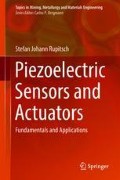Abstract
In this chapter, we will study the fundamentals of the FE method, which are important for simulating the behavior of piezoelectric sensors and actuators. The focus lies on linear FE simulations. Section 4.1 deals with the basic steps of the FE method, e.g., Galerkin?s method. Subsequently, the FE method will be applied to electrostatics (see Sect. 4.2), the mechanical field (see Sect. 4.3), and the acoustic field (see Sect. 4.4). At the end, we will discuss the coupling of different physical fields because this represents a decisive step for reliable FE simulations of piezoelectric sensors and actuators. For a better understanding, the chapter also contains several simulation examples.
Access this chapter
Tax calculation will be finalised at checkout
Purchases are for personal use only
Notes
- 1.
Ansatz functions are also called shape, basis, interpolation, or finite functions.
- 2.
For 3-D electromagnetic problems, edge (Nédélec) finite elements are often applied instead of nodal (Lagrangian) elements.
- 3.
Alternatively to the effective mass matrix \(\varvec{\mathsf {M}}^{\star }\), the Newmark scheme can be defined for the effective stiffness matrix \(\varvec{\mathsf {K}}^{\star }\).
- 4.
The argument for the position \(\mathbf {r}\) is mostly omitted in the following.
- 5.
For the sake of clarity, the arguments for both space and time are mostly omitted in the following equations of this chapter.
- 6.
Alternatively to the approach with amplitude and phase, the complex frequency domain can be represented by real and imaginary parts.
- 7.
The sound pressure distribution corresponds to the spatially resolved sound pressure magnitudes.
References
ANSYS: Software Package for Finite Element Method (2018). http://www.ansys.com
Babuška, I., Suri, M.: p and h-p versions of the finite element method, basic principles and properties. SIAM Rev. 36(4), 578–632 (1994)
Bathe, K.J.: Finite Element Procedures. Prentice Hall, Upper Saddle River (1996)
Brebbia, C.A., Dominguez, J.: Boundary Elements: An Introductory Course, 2nd edn. WIT Press, Southampton (1996)
Briggs, W.L., Van Emden, H., McCormick, S.F.: A Multigrid Tutorial. Society for Industrial and Applied Mathematics (SIAM), Philadelphia (2000)
COMSOL Multiphysics: Software Package for Finite Element Method (2018). https://www.comsol.com
Dorsch, P., Gedeon, D., Weiß, M., Rupitsch, S.J.: Design and optimization of a piezoelectric energy harvesting system for asset tracking applications. Tech. Messen (2017). https://doi.org/10.1515/teme-2017-0102. (in press)
Elvin, N.G., Elvin, A.A.: A coupled finite element circuit simulation model for analyzing piezoelectric energy generators. J. Intell. Mater. Syst. Struct. 20(5), 587–595 (2009)
Erturk, A., Inman, D.J.: Piezoelectric Energy Harvesting. Wiley, New York (2011)
Gedeon, D., Rupitsch, S.J.: Finite Element based system simulation for piezoelectric energy harvesting devices. J. Intell. Mater. Syst. Struct. 29(7), 1333–1347 (2018)
Gui, W., Babuška, I.: The h, p and h-p versions of the finite element method in 1 dimension - part i. The error analysis of the p-version. Numer. Math. 49(6), 577–612 (1986)
Hughes, T.J.R.: Finite Element Method: Linear Static and Dynamic Finite Element Analysis. Prentice Hall, Upper Saddle River (1987)
Hüppe, A., Kaltenbacher, M.: Stable matched layer for the acoustic conservation equations in the time domain. J. Comput. Acoust. 20(1) (2012)
Kaltenbacher, M.: Numerical Simulation of Mechatronic Sensors and Actuators - Finite Elements for Computational Multiphysics, 3rd edn. Springer, Berlin (2015)
Lenk, A., Ballas, R.G., Werthschutzky, R., Pfeiefer, G.: Electromechanical Systems in Microtechnology and Mechatronics: Electrical, Mechanical and Acoustic Networks, their Interactions and Applications. Springer, Berlin (2010)
Lerch, R., Landes, H., Kaarmann, H.T.: Finite element modeling of the pulse-echo behavior of ultrasound transducers. In: Proceedings of International IEEE Ultrasonics Symposium (IUS), pp. 1021–1025 (1994)
LeVeque, R.J.: Finite Difference Methods for Ordinary and Partial Differential Equations. Society for Industrial and Applied Mathematics (SIAM), Philadelphia (2007)
Nierla, M., Rupitsch, S.J.: Hybrid seminumerical simulation scheme to predict transducer outputs of acoustic microscopes. IEEE Trans. Ultrason. Ferroelectr. Freq. Control 63(2), 275–289 (2016)
PZFlex: Software Package for Finite Element Method (2018). https://pzflex.com
Rao, S.: The Finite Element Method in Engineering, 5th edn. Butterworth-Heinemann, Oxford (2010)
Rupitsch, S.J., Nierla, M.: Efficient numerical simulation of transducer outputs for acoustic microscopes. In: Proceedings of IEEE Sensors, pp. 1656–1659 (2014)
SIMetris GmbH: NACS Finite Element Analysis (2018). http://www.simetris.de
Szabo, B., Babuška, I.: Finite Element Analysis. Wiley, New York (1991)
Szabo, I.: Höhere Technische Mechanik. Springer, Berlin (2001)
Wu, P.H., Shu, Y.C.: Finite element modeling of electrically rectified piezoelectric energy harvesters. Smart Mater. Struct. 24(9) (2015)
Ziegler, F.: Mech. Solids Fluids, 2nd edn. Springer, Berlin (1995)
Zienkiewicz, O., Tayler, R., Zhu, J.Z.: The Finite Element Method: Its Basis and Fundamentals, 7th edn. Butterworth-Heinemann, Oxford (2013)
Author information
Authors and Affiliations
Corresponding author
Rights and permissions
Copyright information
© 2019 Springer-Verlag GmbH Germany, part of Springer Nature
About this chapter
Cite this chapter
Rupitsch, S.J. (2019). Simulation of Piezoelectric Sensor and Actuator Devices. In: Piezoelectric Sensors and Actuators. Topics in Mining, Metallurgy and Materials Engineering. Springer, Berlin, Heidelberg. https://doi.org/10.1007/978-3-662-57534-5_4
Download citation
DOI: https://doi.org/10.1007/978-3-662-57534-5_4
Published:
Publisher Name: Springer, Berlin, Heidelberg
Print ISBN: 978-3-662-57532-1
Online ISBN: 978-3-662-57534-5
eBook Packages: EngineeringEngineering (R0)

